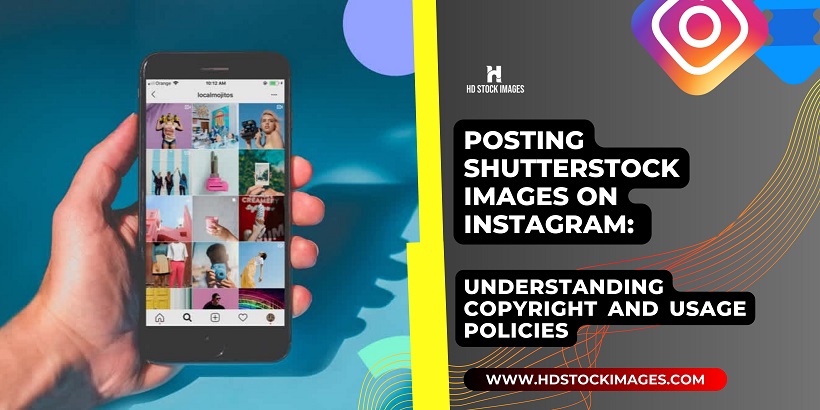1. Introduction
Visual content plays a crucial role in captivating audiences on social media platforms, and Instagram is no exception. As the popularity of Instagram continues to soar, businesses, influencers, and individuals are increasingly relying on eye-catching images to enhance their online presence. Shutterstock has emerged as a leading resource for sourcing high-quality images, providing a vast library of photos, illustrations, and graphics. However, before posting Shutterstock images on Instagram, it is essential to understand the intricacies of copyright and usage policies. This blog post aims to shed light on these aspects, ensuring that Instagram users navigate the world of image sharing responsibly and legally.Also Read This: Is Being a YouTuber a Real Job
2. Understanding Copyright Basics
 Copyright forms the foundation of intellectual property law and governs the rights and protections granted to creators of original works, including images. In simple terms, copyright gives the creator exclusive control over the reproduction, distribution, display, and adaptation of their work. The duration of copyright varies depending on the country, but in most cases, it extends for the life of the creator plus a certain number of years after their death.As it pertains to images, copyright ownership rests with the photographer or the entity that commissioned the work. This means that copying, sharing, or using an image without permission from the copyright holder may constitute copyright infringement, potentially leading to legal consequences.It is important to recognize and respect copyright laws to protect the rights of creators and avoid any legal entanglements when using images, especially on popular platforms like Instagram.
Copyright forms the foundation of intellectual property law and governs the rights and protections granted to creators of original works, including images. In simple terms, copyright gives the creator exclusive control over the reproduction, distribution, display, and adaptation of their work. The duration of copyright varies depending on the country, but in most cases, it extends for the life of the creator plus a certain number of years after their death.As it pertains to images, copyright ownership rests with the photographer or the entity that commissioned the work. This means that copying, sharing, or using an image without permission from the copyright holder may constitute copyright infringement, potentially leading to legal consequences.It is important to recognize and respect copyright laws to protect the rights of creators and avoid any legal entanglements when using images, especially on popular platforms like Instagram.Also Read This: how to host images on siteground
3. Exploring Shutterstock's Usage Policies
 Shutterstock is a well-known platform that provides a wide range of images for various purposes. Understanding the usage policies offered by Shutterstock is crucial to ensure proper and legal utilization of their images on platforms like Instagram. Here are some key aspects to consider:
Shutterstock is a well-known platform that provides a wide range of images for various purposes. Understanding the usage policies offered by Shutterstock is crucial to ensure proper and legal utilization of their images on platforms like Instagram. Here are some key aspects to consider:A. Overview of Shutterstock as a popular image platform:
Brief introduction to Shutterstock's role as a leading provider of stock images.Emphasis on the importance of adhering to their usage policies.B. License types offered by Shutterstock:
- Shutterstock offers different types of licenses, each with its own specific usage rights and restrictions. It is essential to familiarize yourself with these licenses to determine which one suits your needs. The main license types include:
- Royalty-free licenses:
- Explanation of how royalty-free licenses work and their broad usage permissions.
- Clarification that "royalty-free" does not mean the image is free of charge.
- Editorial licenses:
- Definition and purpose of editorial licenses, which are typically used for newsworthy or journalistic content.
- Mention of limitations on commercial use for editorial images.
- Enhanced licenses:
- Overview of enhanced licenses, which provide additional usage rights beyond the standard licenses.
- Emphasis on the added benefits and extended permissions offered by enhanced licenses.
C. Understanding permitted usage under each license type:
- For each license type, it is essential to grasp the specific ways in which you can use the images. This section should cover:
- Commercial use:
- Explanation of using Shutterstock images for promotional or commercial purposes.
- Mention of limitations, if any, on the number of copies, impressions, or viewers.
- Non-commercial use:
- Discussion of utilizing images for personal or non-profit purposes.
- Caution against using images with commercial intent in non-commercial contexts.
- Editorial use:
- Elaboration on the appropriate applications of editorial images.
- Emphasis on using such images in editorial or newsworthy contexts only.
D. Restrictions on usage and potential violations:
- Highlighting certain usage restrictions imposed by Shutterstock, such as using images in a defamatory or offensive manner.
- Mention of potential violations that can result in legal consequences or account suspensions.
Also Read This: What Happened to Tara Michelle’s YouTube Friendships
4. Posting Shutterstock Images on Instagram
When it comes to posting Shutterstock images on Instagram, it is important to navigate the platform's terms of service and copyright considerations. Here are some key points to consider:A. Instagram's terms of service and copyright considerations:
Overview of Instagram's terms of service and the responsibilities users have in adhering to copyright laws.Emphasis on the need to obtain proper permissions or licenses for using images on the platform.B. Choosing the appropriate Shutterstock license for Instagram:
Guidance on selecting the right Shutterstock license that aligns with Instagram's usage requirements.Highlighting the importance of considering the purpose, audience, and intended use of the image.C. Complying with Instagram's image guidelines and quality standards:
Understanding Instagram's image specifications, such as resolution, aspect ratio, and file formats.Tips for properly resizing and optimizing Shutterstock images to meet Instagram's requirements.D. Tips for crediting the image source on Instagram:
Educating users on the significance of giving proper credit to the Shutterstock image source.Providing guidelines on how to appropriately attribute the image within the Instagram post or caption.By following these considerations and guidelines, Instagram users can confidently and responsibly incorporate Shutterstock images into their Instagram content while respecting copyright laws and Instagram's usage policiesRT Shutterstock: See some of our favorite images on Instagram: https://t.co/HDMCJegxQi pic.twitter.com/xZrruOiGpk
— marimari (@marimarisisi) April 18, 2016

 admin
admin








